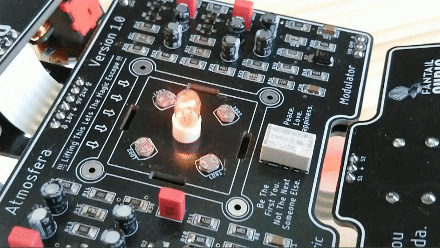The final calibration involves adjusting the trim pots in order to get the blub to react in a way that sounds best. You could argue that the calibration of the bulb is the most important factor in how a Uni-Vibe sounds. Along with having the right LDRs. So maybe 1A and 1B depending on the day.
The two main trim pots that influence the bulb's behaviour are the Bulb Bias and Bulb Offset:
Bulb Bias: Controls the overall brightness of the bulb. Turn it up, and the bulb gets brighter. Turn it down; the bulb dims. So it controls to intensity of the light the LDRs are exposed to.
Bulb Offset: Controls the amount of time the bulb turns off during each cycle of the oscillation. A higher offset means the bulb will be off longer and less offset more the bulb to stay on. This controls the amount of time the LDRs are exposed to the light.
Below: The Bulb Offset and Bulb Bias trim pots.

Both of these controls are very interactive with each other so I begin by setting the Bulb Offset to the default value of 100k like the original and turn the Bulb Bias all of the way down so the bulb will be totally off once everything is powered up.
Next, the speed is turned up to halfway and the intensity to full before slowly turning up turning the Bulb Bias up until there is a nice glow. This is where I plug in the guitar and start dialling things in until everything sounds right. Which, of course, is very subjective but there are a bunch of great-sounding clips on YouTube of vintage units that provide a great reference tool.
This whole process is more of an art than a science. In general, a brighter bulb with more offset gives more throb but since the intensity of the LFO increases as you turn up the speed, a quirk of the design and what gives the Uni-Vibe its character, this might sound good on a certain setting but not so much on others. So I tend to tune things so they sound good across the entire range of speed and intensity controls.
Below: It's alive.

Once everything sounds great, the last thing to do is adjust the LED Bias in order for the external LED to mimic the behaviour of the bulb to provide that visual feedback of the speed and intensity settings.
Below: The LED Bias trim pot.

Now everything is set, it is time for everything to be boxed up in the enclosure.
~ Blake.





